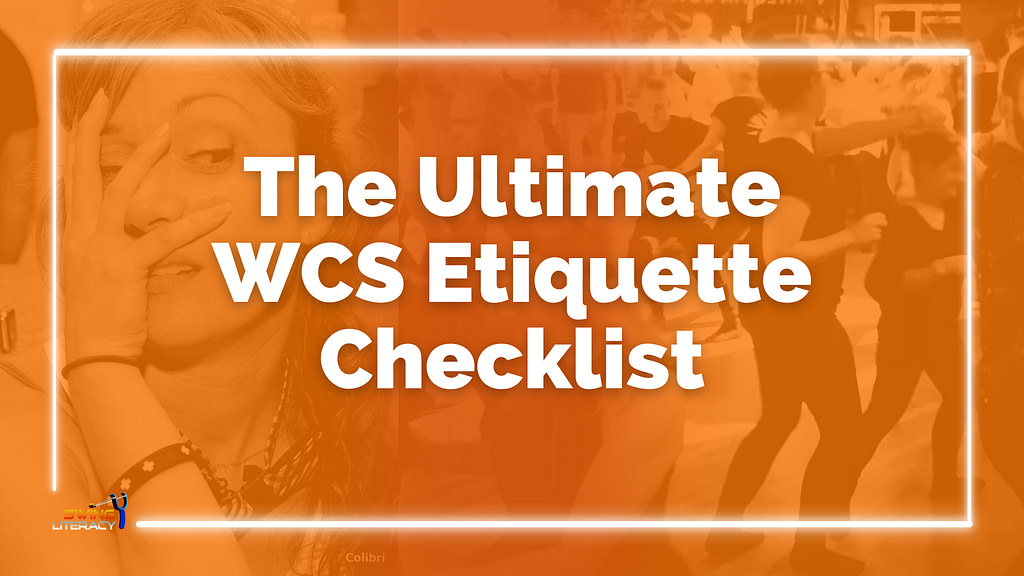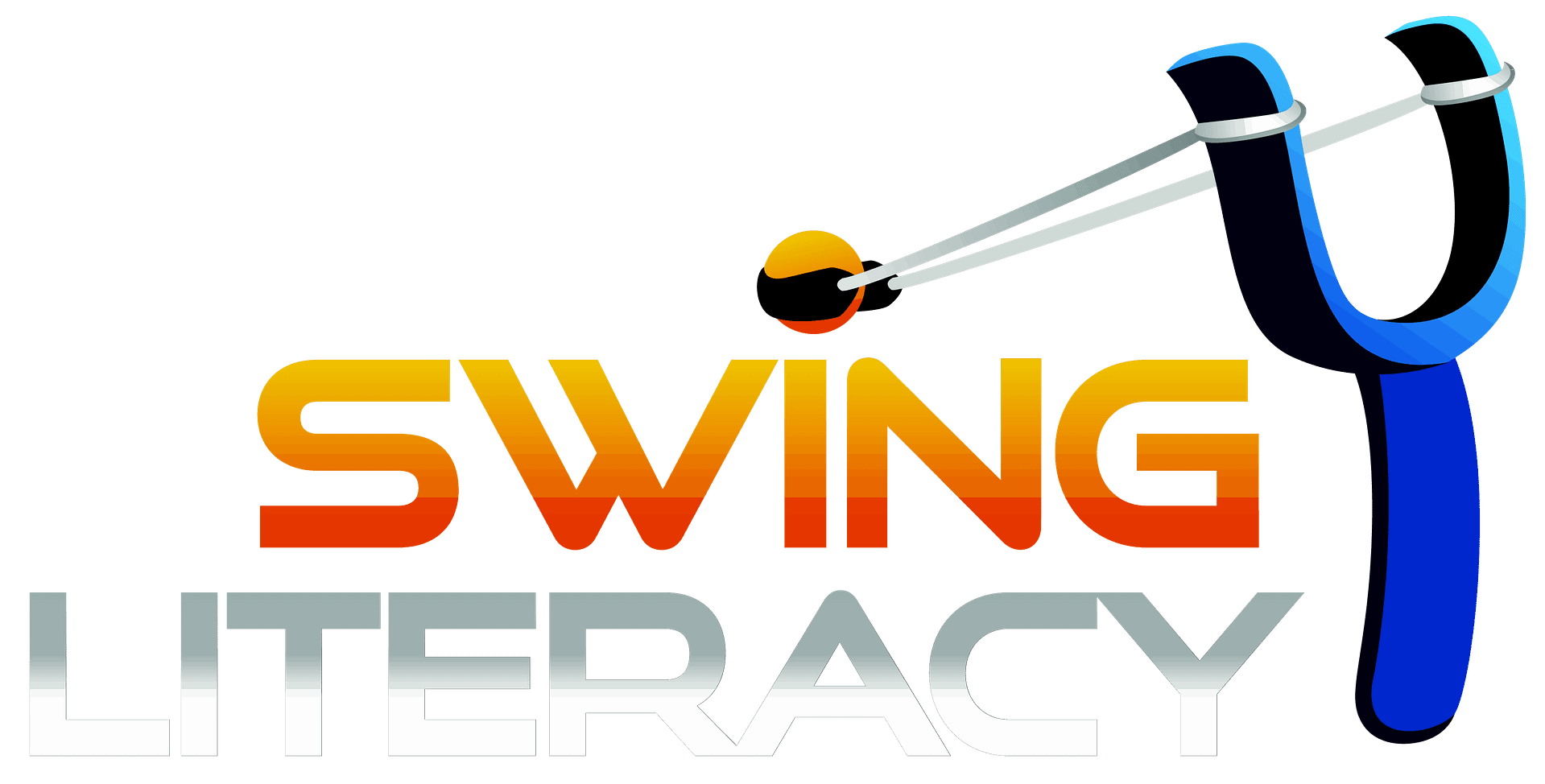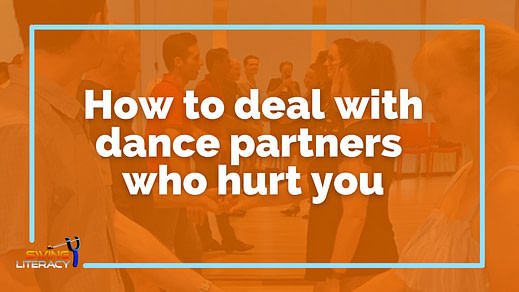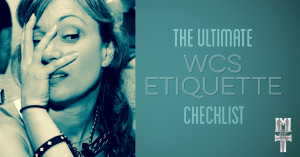No products in the cart.

The Ultimate WCS Etiquette Checklist
Reading Time: 16 minutes remaining
Etiquette is a part of the culture of social dancing that is often taken for granted.
We all assume that since we feel like we are doing fine, that others will perceive us the same. Everyone assumes the advice applies to everyone but themselves.
...but are you SURE?
You may have heard some of these tips before, but some are rare gems that no one speaks aloud but are implicit in the Westie scene. Use this as a checklist to make sure you are covering all your bases.
Then pass it on in your community so others can check themselves too!
Physical Respect
- Respect your partner’s personal space: avoid breathing on them in close proximity, keep your hands away from their “no-zones” and their hands away from yours.
- Escort your partner onto the floor. Take caution in guiding them through the other couples already dancing. Escorting them off the floor is nice if you happen to be headed in the same direction.
- Leaders, keep aware of the couples around you and get the other leaders’ attention before committing to your chosen slot.
- Protect your partner from impending collision. If a collision should occur, apologize to the other party, regardless of fault. Check your partner for injury. If an injury occurs, escort your partner off the floor, and tend to their needs.
- Almost everyone has a past or current injury they are trying to protect. Go easy in the beginning and test them out first, or even better, get verbal agreement before trying things like dips and drops. Never assume that your partner has the flexibility, balance, or confidence to perform all your fancy tricks.
- Inebriation: Social dancing is a party activity, so some drinking can be expected, but know your limit. You need to be at least sober enough to maintain balance and not hurt your partner.
- “Dance to your partner’s level” is common advice, but not perfect. It is not expected that you need to dance as well as your higher-level partner. If you are a higher level dancer than your partner, you should take your partner’s skill set into consideration, but this doesn’t necessarily mean that you need to keep it basic, or “dumb down” your dance. Always seek to gently elevate your partner, and never let them see you bored or annoyed.
- Consider your partner's perspective when choosing what to wear: think twice about sharp jewelery, dangling hair/accessories, baggy sleeves, and sweaty bare arms.
Invitations to dance
- When asked to dance, try your best to agree with enthusiasm
- Normalize including the role you are proposing in your invitation. For example, instead of "Would you like to dance?" try "Would you like to dance? I can lead"
- Don't be surprised if you are asked to dance a role you aren't used to. If you aren't confident in accepting this challenge, no big deal, just decline by saying, "Oh, thanks but I only follow/lead".
- It is considered polite but not essential to reciprocate an invitation: If someone asks you to dance, return the favour by extending the invitation to them next time. Avoid asking the same person to dance more than twice in a night – give them a chance to ask you, or move around the room, asking new people.
- If you really enjoyed a dance, you might ask your partner for a second song, but there should be no expectation of them to accept. Second songs are more common in Europe than in North America.
- If absolutely necessary to decline a dance, do so by gently saying “thank you, but I need a water/rest/pitstop”, then if you do want to dance with them, try your best to find them later.
- Take caution before interrupting someone in conversation to invite them to dance.
- Try not to refuse a dance with ‘NO’ and just leave it at that. After declining one invitation, avoid turning around and accepting another invitation for the same song unless you communicate your reason to the person you turned down.
- Never demand a dance, or pull a partners hand without making eye contact or a verbal request.
- Don’t refuse an invitation just because you think you’re not good enough to dance with them, or because you think the partner inviting you is not good enough to dance with you.
- Don’t ask someone to dance when they are en route to the toilet.
- Don’t ask someone to dance while they are in the middle of eating.
- Don’t ask two people to dance at the same time (unless you are proposing a steal dance). Avoid awkwardness by asking one then the other.
Interaction during the dance
- Look at your partner while dancing, as much as possible while constantly monitoring your floor space. If you are shy, look at their chin instead of their eyes.
- SMILE, especially in recognition of your partner’s styling contributions.
- Keep conversation to a minimum on the floor and concentrate on the task at hand: dancing.
- Do apologize for accidental hand slips or bumps.
- If you realize you are off-time, pause and groove to find the beat – don’t keep dancing off time.
- Ladies, don’t assume the guys are looking at your chest – they are likely just looking at your feet. Guys, try not to let your eyes rest on her chest.
- Don’t apologize for being a beginner!
- Never abandon a partner on the floor mid-song, unless you have a health/safety emergency.
Feedback and Mistakes
- Improvisation means that no dance will ever be the same. Variety is refreshing, and mistakes should be welcomed as opportunities to create something new.
- Refer a greener partner to a teacher for advice rather than giving it yourself.
- If you and your partner want to have a conversation about how to improve a particular move, take it off the social floor.
- If you are uncomfortable or getting hurt, use your words to speak up and request politely but assertively what you need your partner to change for safety.
- Mistakes happen, but they are of little consequence. It is unnecessary and annoying to attempt a “failed” move repeatedly in an effort to “get it right”.
- Never assume a mistake is your partner’s fault. Check yourself first.
- No one “owes” you anything on the dance floor. It is unrealistic to expect every partner to offer you the type of connection you feel is ideal.
- Never take it upon yourself to correct your partner’s dancing on the floor.
- Never grab, yank, or forcefully ask for connection at anytime during a social dance
- Never use any version of the phrase, “You’re not supposed to do it that way”.
Roles
- Don't assume someone's preferred role: when inviting or accepting an invitation to dance, I always either state my intention, "Ok with me following?" or I ask, "Would you like to lead or follow?"
- No one has the right to correct their partners unless it is a teacher in the context of a lesson. It is considered unacceptable to offer unsolicited criticism on the social dance floor, no matter how much you think you are trying to help. Encouraging words only, please.
- The role of leader is simply one half of an equal partnership. The word “leader” does not mean “advisor”, does not hold “seniority” over the follower, and does not give you license to teach, tutor, or coach your partners.
- Teachers in the room do not provide teaching services during a social party – they are relaxing. Tread cautiously when chatting over a meal or drinks – they might prefer to avoid shop talk when they are off the clock.
- Don't ask teachers for advice or feedback after a dance, unless you have a prior arrangement. The washroom is off-limits: don't try to set up a private lesson or other business while you both are “doing your business”.
In the room
- Introduce yourself to any new faces in the room. Move around the room and dance with different partners.
- Dance with partners of all levels: those higher level than you will give you the opportunity to try harder skills, but those lower level than you will authentically test your basic skills and give you a calm opportunity to work on your precision and adaptability. Everyone has value and can teach you something whether they know it or not.
- While spectating, it is common to applaud an exceptionally good social dance you observe.
- When the floor is crowded, dance smaller. If this is a challenge for you, seek out more training on this.
- Be conscious of the slot directions of other dancers and align with them, not perpendicular to them.
- Out of the room, take care of each other. Escort vulnerable people to their cars, watch out for underage drinking etc.
- Partner stealing is a fun game friends play occasionally, but it is inconsiderate to steal someone while they are enjoying a rare dance with a Pro.
- Wait to be invited/included in group activities such as rounds of drinks or hotel room parties. Ask permission first and avoid party crashing or “mooching” others' food/alcohol.
- Try not to isolate yourself in one corner and dance with the same friends all night.
- Don’t discriminate based on age, gender, aesthetics, or body shape. You will often be wrong in your assumptions and miss out on some amazing dances.
- Don’t stalk the higher level dancers and pros. Invite them to dance, have a dance, then move on. Don’t form a queue – they have the right to chose who they dance with and when.
- Don’t infringe on Pro’s “down time” – stay out of the staff room and avoid crowding the DJ.
- Never get aggressive with the DJ – if they refuse to play your request, there is usually a very good reason.
- Don't put drinks or personal items on or near the DJ equipment, or open containers where they might spill where dance shoes might be walking. If you spill, clean it up.
- Don't assume you can join in on a steal dance. Here's an article on this topic.
Hygiene
- Dancing is an intimate activity, as well as a sport. Expect to be touched in appropriate ways in any zone that is not your face or typically covered by underwear. Manage your hygiene accordingly.
- Manage your breath: be conscious about your choice of pre-dance meal. Always have gum or mints ready.
- Remember that dancing is an exercise activity: wear lots of deodorant, not just antiperspirant – these are two different products – check to make sure you are applying the combination.
- You will be perspiring a lot: bring an extra shirt, and maybe a towel & fan.
- Never forget to change shirts between a long day of work/workshops and the evening dance party.
- Never leave the washroom or return from smoking without washing your hands.
- No hand lotion or strong scents.




 Etiquette is a part of the culture of social dancing that is often taken for granted. We all assume that since we feel like we are doing fine, that others will perceive us the same. Everyone assumes the advice applies to everyone but themselves. You may have heard some of these tips before, but some are rare gems that no one speaks aloud but are implicit in the Westie scene. Use this as a checklist to make sure you are covering all your bases.
Etiquette is a part of the culture of social dancing that is often taken for granted. We all assume that since we feel like we are doing fine, that others will perceive us the same. Everyone assumes the advice applies to everyone but themselves. You may have heard some of these tips before, but some are rare gems that no one speaks aloud but are implicit in the Westie scene. Use this as a checklist to make sure you are covering all your bases.
Great. Info thanks
GREAT Tips!! Thanks!
Brilliant! Well said.
Wow that was a great effort you made to write all of that, I appreciate your wisdom and good advice!
All great info…
I would add that when you go out on the floor organize your slot to line up with the normal floor pattern at that venue and if in doubt, line up WITH the other dancers on the floor.
-It boggles my mind the see people that obviously have some skills line up across other people’s slots!?!
How about: Finish food completely, including chewing and swallowing and washing hands, before asking someone to dance. Or better yet, refrain from eating altogether in between dances. Odors, crumbs and other residue are noticed by your partner who must enter your personal space and touch your hands in order to dance with you. You chose to consume that particular food not them.
I like how you pointed out that you shouldn’t dance just amongst yourselves. I have noticed clicky groups that never ask other people outside their circle to dance and some of them act like your bothering them but they will dance anyways. They never ask anybody to dance outside their circle unless it is a pro. They could take away from this article.
Good read.
Some of the advice about asking is IMO way off base. Turning people down with an intentional lie when you, in fact, do not want to dance with them puts you in a morally wrong place, and leaves them feeling they can ask again later. Feeling obligated to later dance with someone you turned down misses the whole point of being *able* to turn someone down. In particular this puts pressure on women, who are often expected to accommodate men’s requests despite their own preferences.
The Blues and Fusion dance scenes have (mostly) moved to a much healthier approach of encouraging enthusiastic consent, while trying to remain open to different types of partners and skill levels. Sure, it stings to get turned down, and maybe you will never get an explanation as to why. But much better that than dancing with someone who is doing it out of a sense of obligation or social norms.
It’s absolutely like you said. There is so much, what should be unnecessary to mention.
But doing a lot of social dance I encountered way too many of these bad habits.
As a DJ of muliple genres (WCS, Salsa, Kizomba) let me say “Thank you!” for your comments on crowding and demanding the DJ!!! I don’t think many people realize the concentration a good DJ must maintain to keep a good flow/vibe to their set, or how nervous it makes us having people blindly crowd around our VERY expensive gear. If I may add: NEVER put things on the DJ’s stand or equipment, i.e. drinks, purses, shoe bags, or ANY part of your body! As a male dancer of many years I could add many things to this, but I think this is a well written start! My favorite myth: “If you can lead, I can follow”. Thank you Tessa.
I look forward to these essays, and Share them.
SO good of you to share your knowledge and wisdom with the rest of us. If everyone would read and heed them, dancing would be even more fun than it is!
Under ‘Hygiene’, I suggest modifying and expanding the last bullet to “No strong scents – sources include cologne, perfume, and hand lotion.” I agree with the deodorant portion of the associated bullet but recommend NOT using antiperspirant. There are some good natural deodorants with enzymes that eat the odor-causing bacteria; in contrast, the alums in antiperspirants are problematic – and when combined with sweat can cause yellow clothing stains. While we’re on the subject of body odor, stinky feet and sour jeans are unpleasant; rotate your shoes, wear bamboo socks, and pre-treat clothes before putting in the wash. If you’re wearing street shoes, make sure they’re clean before you step on the floor. Please keep your fingernails trimmed. Leaders – no wristwatches or other arm accessories that can catch in a follower’s hair and keep the hard items (e.g. keys) out of your front pockets. Followers – no billowy clothing around the middle.
Under ‘Physical Respect’, I suggest adding “Dance small when the floor is crowded: a short, narrow slot and your arms can go up but not out.”
Regardless of the form of dance, I think one should always accept a polite offer to dance if you are ready to dance… but I do grant folks some leeway if they aren’t comfortable with dancing with someone of the same gender, switching roles, and/or dancing other than standard patterns. For example, at a Bachata dance, I’ll ask another woman to dance with “Would you mind following a WCS lead?” Role switching back and forth during a dance is cool – but only if both parties are comfortable with and expecting mid-stream switching.
‘Out of the Room’ – Make sure that everyone stays safe, including escorts to parking. Respect personal boundaries. It takes a village: make sure that the teen dancers aren’t pressured into adult activities.
Just returned home from a national WCS event in Boston, Although there were many supportive leaders in attendance, I did encounter quite a few that felt it necessary to give me tips during workshops, on the social floor and even during the newcomer competition. My confidence took a nosedive which I quickly recovered from. Decided not to be as hard on myself as some of my partners. This is a great resource. Thank you –
If a couple (boyfriend/ girlfriend) husband/wife) are sitting together and you want to dance with one or the other always acknowledge their partner and show that person respect and courtesy.. Don’t treat the partner as if they don’t exist. It is rude.
Thanks for such a detailed and thoughtful treament of all of this. Let me add one more issue;
At a certain point of experience it seems some dancers become infatuated with “drifting” their slot, and navigate over 3 or 4 slot spaces. While this is great in demos and comps where the floor is relatively open, it drastically increases risks of collision on crowded social floors. It’s disrespectful of the other dancers on the floor, and it’s dangerous. You don’t see the best dancers doing this. (The people you know could pull it off save it appropriate times and places).
Recognize that if you have carved out extra space on the floor, people aren’t moving back in awe of your “mad dance skills”. They are just trying to protect themselves and their partners from your recklessness.
Myles & Tess <3
<3
Great advice! Dancers of all levels don’t think you know it all. I’ve been dancing longer then some of you have been around and on the dance floor.
I can honestly say….I have learned and will apply some of their advice/tips.
Like I always say…YOU CAN ALWAYS LEARN SOMETHING NEW!
Thank you Tessa, agree with 99% of your tips,etc. One thing i would like to add to the area of dance floor etiquette is this: whenever you step on another dancers foot, ankle, etc. or graze, bump, or collide with any part of another dancers body, please make eye contact, no matter who’s at fault…smile, say “excuse me” or “I’m so sorry” or an appropriate response, because it is rude not to acknowledge the encounter and keep dancing as if nothing happened! It’s called, “being considerate!”
EXCELLENT article !
Every wcSWING dancer should read and follow !
A Class on this subject should be available for newbies (& oldies) at major dance conventions.
Great info.
I need help with what to say to leaders who use their thumb to hold connection—I've tried asking them to be gentle with these piano player fingers as I ask them to remove their thumb. Some don't realize they're doing it and sometimes they just do it when they are turning me—which is dangerous in that they typically think they have to make me turn and don't have a sense of timing as to when to bring the arm down. Sometimes the music is too loud for them to hear what I'm saying. Sometimes I withdraw my hand–which if I can't communicate at that moment they think they should hold tighter! Not that I'm intentionally protecting myself. As I'm writing this, I realize I need to be proactive—but not sure what exactly would be the best thing to say.
Hi Lois, I recommend reading the article about Feedback which is mentioned here, and here's another one more specific to your concern: https://www.swingliteracy.com/how-to-deal-with-dance-partners-who-hurt-you/
Thanks for that link—-very helpful. Yes, I suffer from genderational programming and continue to work on that in personal life—-but hadn’t put it together with dance. Thanks also for phrase examples to help with communication.